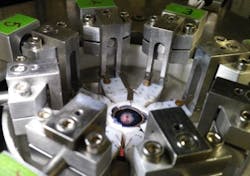Ultrafast laser method shows promise for improving presbyopia correction
A team of researchers at Laser Zentrum Hannover e.V. (LZH; Germany) and collaborators have been developing a virtual model for correcting presbyopia (a form of farsightedness that occurs typically in middle and old age) that involves an ultrafast laser. In their femtosecond lentotomy method, the crystalline lens is made flexible again by performing micro-cuts with a femtosecond laser. The aim of the method, part of the research team's RayFEye project, is to make eye surgery results predictable.
Related: Ultrafast laser, OCT, and adaptive optics combine for accurate ophthalmic laser surgery
The Image-Guided Laser Surgery Group of the Biomedical Optics Department at LZH is developing an experimental setup in which the influence of the micro-cuts on the crystalline lens can be measured. What's special about the complex setup is that it can stretch and unstretch a sample crystalline lens, thus simulating different focus distances of the eye. The scientists can measure the changes in the beam path (ray tracing) through the lens both before and after the micro-cuts in the eye have been made.
With the results of these experiments, cutting patterns for the surgical correction of presbyopia can be determined and optimized. Cutting patterns and measurement results of the experiments are then entered into simulation software, which creates a virtual lens model on which the surgical correction can be simulated prior to the surgery.
The software is undergoing further development to customize it for clinical use, with the ability to simulate surgeries a priori to improve the results of eye corrections.
RayFEye project partners include Optimo Medical AG, which is developing the OptimEyes software, and ROWIAK GmbH, which manufactured the femtosecond laser system.
For more information, please visit www.lzh.de.
Follow us on Twitter, 'like' us on Facebook, connect with us on Google+, and join our group on LinkedIn

